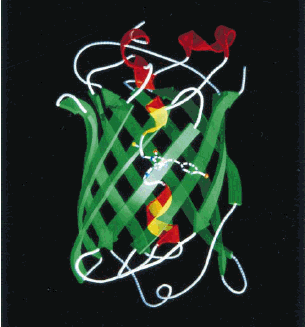|
|
|
|
|
|
|
News & Views item - October 2008 |
![]() Nobel Prize for Chemistry Awarded for the Discovery and Development of the
Green Fluorescent Protein, GFP. (October 9, 2008)
Nobel Prize for Chemistry Awarded for the Discovery and Development of the
Green Fluorescent Protein, GFP. (October 9, 2008)
The Royal Swedish Academy of Sciences announced that a Japanese, Osamu Shimomura, and two Americans, Martin Chalfie and Roger Y. Tsien, have been awarded the 2008 Nobel Prize for Chemistry for the discovery of the green fluorescent protein (GFP), and its subsequent development as a preeminent biomedical research tool.
 |
| The tertiary structure of GFP, displaying its can-like shape with the α-helix, containing the chromophore, threading up through the can (Brejc et al., 1997). |
The Academy's announcement states:
This year's Nobel Prize in Chemistry rewards the initial discovery of GFP and a series of important developments which have led to its use as a tagging tool in bioscience. By using DNA technology, researchers can now connect GFP to other interesting, but otherwise invisible, proteins. This glowing marker allows them to watch the movements, positions and interactions of the tagged proteins.
Researchers can also follow the fate of various cells with the help of GFP: nerve cell damage during Alzheimer's disease or how insulin-producing beta cells are created in the pancreas of a growing embryo. In one spectacular experiment, researchers succeeded in tagging different nerve cells in the brain of a mouse with a kaleidoscope of colours.
Osamu Shimomura first isolated GFP from the jellyfish Aequorea victoria, which drifts with the currents off the west coast of North America. He discovered that this protein glowed bright green under ultraviolet light.
Martin Chalfie demonstrated the value of GFP as a luminous genetic tag for various biological phenomena. In one of his first experiments, he coloured six individual cells in the transparent roundworm Caenorhabditis elegans with the aid of GFP.
Roger Y. Tsien contributed to our general understanding of how GFP fluoresces. He also extended the colour palette beyond green allowing researchers to give various proteins and cells different colours. This enables scientists to follow several different biological processes at the same time.
Only as many as three individuals can share in receiving a Nobel prize and Douglas Prasher at the Woods Hole Oceanographic Institute, Massachusetts, who isolated the gene that expresses GFP lost out.
Professor Tsien on hearing the news, said that Prasher was an obvious omission from the list of laureates: "I'm sure the committee had a difficult decision."
Reporting the award ScienceNOW wrote: "Last year, more than 12,000 papers reported using GFP and other fluorescent proteins, according to Marc Zimmer, a chemist at the University of Connecticut, New London, and author of Glowing Genes, a book about the discovery of fluorescent proteins. Today, GFP and other fluorescent proteins "are probably as important as the development of the microscope," he says. That underscores the value of basic research: If Shimomura's pursuit of jellyfish fluorescence were funded today, says Zimmer, it would be more likely to earn scorn than anything else. "It's a great candidate for the IgNobels".
Click here![]() to read the committee's information file.
to read the committee's information file.
__________________________________________
Osamu Shimomura, Japanese citizen. Born 1928 in Kyoto, Japan. Ph.D. in organic
chemistry 1960 from Nagoya University, Japan. Professor emeritus at Marine
Biological Laboratory (MBL), Woods Hole, MA, USA and Boston University Medical
School, MA, USA.
www.conncoll.edu/ccacad/zimmer/GFP-ww/shimomura.html
Martin Chalfie, US citizen. Born 1947, grew up in Chicago, IL, USA. Ph.D. in
neurobiology 1977 from Harvard University. William R. Kenan, Jr. Professor of
Biological Sciences at Columbia University, New York, NY, USA, since 1982.
www.columbia.edu/cu/biology/faculty/chalfie/Chalfie_home/
Roger Y. Tsien, US citizen. Born 1952 in New York, NY, USA. Ph.D. in physiology
1977 from Cambridge University, UK. Professor at University of California, San
Diego, La Jolla, CA, USA, since 1989.
www.tsienlab.ucsd.edu
____________________________________
[Note added October 24, 2008:
"If Marty and Roger want to show me some gratitude, they can always send some cash. I'm accepting gifts and donations."
Douglas Prasher, the biochemist who isolated the jellyfish gene behind green fluorescent protein (GFP). Work on GFP earned Martin Chalfie, Roger Tsien, and Osamu Shimomura the 2008 chemistry Nobel, but Prasher--who gave Chalfie and Tsien the gene in the early 90s--now drives a courtesy shuttle for a car dealership in Huntsville, Alabama.]